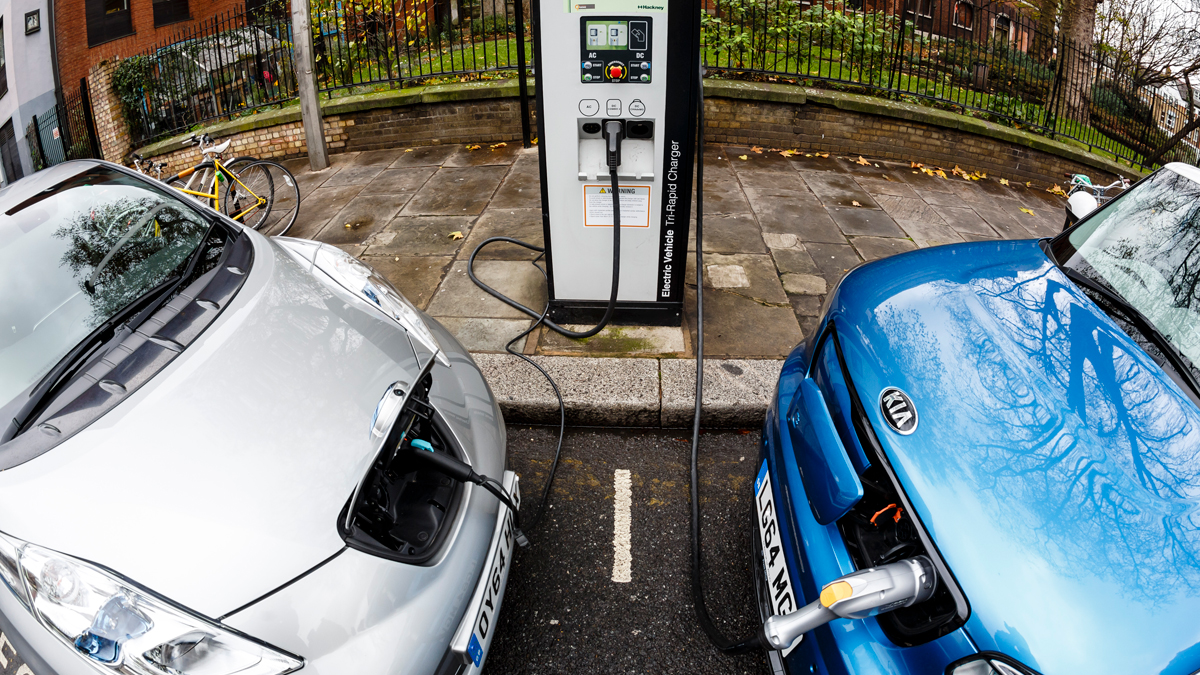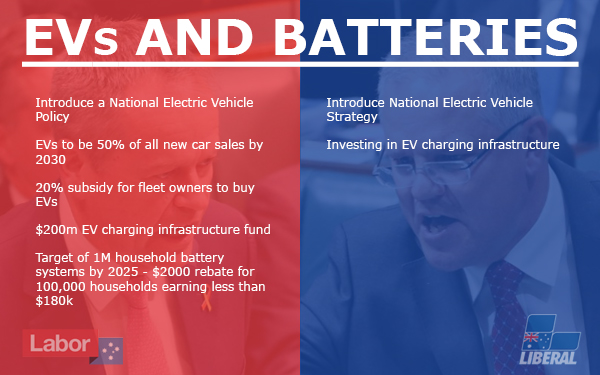No spin: The EV policies that will affect ASX stocks

Picture: Getty Images
As the major parties switch up the spin cycle ahead of the May 18 federal election, we’ve hunted down the policies that will affect listed companies — so you don’t have to.
Electric vehicles (EVs) is a big topic that the battery metals players will be watching closely, but there is still some confusion over the various policies.
We’ll go into depth on them, but first, here’s the tl;dr version:

What the experts say
Tony Wood, energy program director for the Grattan Institute — which contributes to public policy in Australia – said one of the reasons Labor took a position on electric vehicle uptake was because it was trying to introduce an economy-wide emissions reduction target.
“Emissions from the transport sector are about 20 per cent of the total,” he told Stockhead.
“It’s reasonably significant and secondly, of the transport sector, about 55 per cent of emissions come from small passenger vehicles and small commercial vehicles.
“So to be able to provide some degree of credibility around their policy to reduce emissions, they’ve got to have a position on transport, not just electricity.”
There isn’t a whole lot of finite detail in Labor’s or the Coalition’s election policies, which has made it a little difficult to understand just how they will be put into effect.
“While there’s talk of [Labor] having a 50 per cent target, they’re not actually proposing to do anything that would actually force that to happen,” Wood said.
“They haven’t thought it through yet as how this would actually be done in practice. I think that’s still broadly a useful and important marker in terms of setting a broad target, but I don’t think it actually is yet in any way formed as a policy.
“The other side of it is the Coalition obviously hadn’t thought about it very much.
“I think Labor is doing less than they’re giving the impression and the Coalition is doing slightly more than they’re giving the impression, but neither of them have got yet really a clear strategy.”
- Subscribe to our daily newsletter
- Join our small cap Facebook group
- Follow us on Facebook or Twitter
In-depth: The details affecting listed companies
Labor has set an EV target of 50 per cent of new car sales by 2030, while the Coalition doesn’t have a target.
Labor is also setting a government EV target of 50 per cent of new car purchases and leases by 2025, and encouraging an increase in EVs in fleets by allowing businesses to immediately deduct 20 per cent off any new EV valued at more than $20,000.
The benefit of these initiatives to battery metals explorers and miners will mostly be indirect.
Warren Pearce, CEO of the Association of Mining and Exploration Companies, said most of Australia’s battery metals resources will end up in the batteries used in EVs.
“If there’s a larger local market fuelled by local purchases there obviously is going to be a much stronger market for us to sell into locally rather than just overseas,” he told Stockhead.
More directly, Labor wants to review battery metal extraction and processing in Australia and make R&D funding a priority for battery metals.
This is a positive move for small cap players like Lithium Australia (ASX:LIT) and Lepidico (ASX:LPD).
Lithium Australia is already very advanced down the path of becoming the first Australian company to do everything from mine lithium to make batteries all under one roof.
Lepidico, meanwhile, is advancing a process to make lithium hydroxide — which attracts a premium price — from all hard rock lithium mines.
It’s not just lithium players though that will benefit from the EV election policies.
Other ASX-listed small caps in cobalt, graphite, nickel, copper and rare earths will also reap the rewards of increased EV demand in Australia.
Australian Mines (ASX:AUZ) plans to start building its Sconi nickel and cobalt project in Queensland this year.
Clean TeQ (ASX:CLQ), meanwhile, is aiming for first production in 2021 at its advanced Sunrise nickel-cobalt project in New South Wales. The project is fully permitted and development ready.
Rare earths player Arafura Resources (ASX:ARU) plans to produce the neodymium and praseodymium needed to make the ultra-strong rare earth permanent magnets used in the drivetrain of battery electric and hybrid electric vehicles.

Commissioning of the company’s Nolans project in the Northern Territory is slated for early to mid-2022.
The battery benefit
Meanwhile, Labor’s push to have 1 million household battery installations by 2025 is likely to directly benefit small caps like Redflow (ASX:RFX), which makes residential batteries for homes and small businesses.
Labor says it will provide a $2,000 rebate for 100,000 households on incomes of less than $180,000 per year to purchase and install battery systems, as well as low-cost loans for households.
This will make household batteries for energy storage less expensive and hopefully increase more homeowners to buy them.
Liberal and Labor are also both promising investment in EV infrastructure, which is good news for Rectifier Technologies (ASX:RFT), which manufactures and sells EV charging units.
Australia is going to require more charging infrastructure as its EV uptake picks up.
There isn’t much detail around the Coaltition’s planned spend on EV charging infrastructure, but Labor will establish a $200m fund to roll out infrastructure across the country.
Labor will also introduce regulatory reform that requires all federally funded road upgrades to incorporate EV charging infrastructure and establish an EV COAG agenda to improve coordination of EV take-up and related infrastructure planning.
At Stockhead, we tell it like it is. While Australian Mines and Arafura Resources are Stockhead advertisers, they did not sponsor this article.
UNLOCK INSIGHTS
Discover the untold stories of emerging ASX stocks.
Daily news and expert analysis, it's free to subscribe.
By proceeding, you confirm you understand that we handle personal information in accordance with our Privacy Policy.








